Complex Numbers and Quadratic Equations Class 11 Notes Maths Chapter 5
Wednesday, August 25, 2021
Team Knowledge Test CBSE
CBSE Class 11 Maths Notes Chapter 5 Complex Numbers and Quadratic Equations
Imaginary Numbers
The square root of a negative real number is called an imaginary number, e.g. √-2, √-5 etc.
The quantity √-1 is an imaginary unit and it is denoted by ‘i’ called Iota.
Integral Power of IOTA (i)
i = √-1, i2 = -1, i3 = -i, i4 = 1
So, i4n+1 = i, i4n+2 = -1, i4n+3 = -i, i4n = 1
Note:
- For any two real numbers a and b, the result √a × √b : √ab is true only, when atleast one of the given numbers i.e. either zero or positive.
√-a × √-b ≠ √ab
So, i2 = √-1 × √-1 ≠ 1 - ‘i’ is neither positive, zero nor negative.
- in + in+1 + in+2 + in+3 = 0
Complex Number
A number of the form x + iy, where x and y are real numbers, is called a complex number, x is called real part and y is called imaginary part of the complex number i.e. Re(Z) = x and Im(Z) = y.
Purely Real and Purely Imaginary Complex Number
A complex number Z = x + iy is a purely real if its imaginary part is 0, i.e. Im(z) = 0 and purely imaginary if its real part is 0 i.e. Re (z) = 0.
Equality of Complex Number
Two complex numbers z1 = x1 + iy1 and z2 = x2 + iy2 are equal, iff x1 = x2 and y1 = y2 i.e. Re(z1) = Re(z2) and Im(z1) = Im(z2)
Note: Order relation “greater than’’ and “less than” are not defined for complex number.
Algebra of Complex Numbers
Addition of complex numbers
Let z1 = x1 + iy1 and z2 = x2 + iy2 be any two complex numbers, then their sum defined as
z1 + z2 = (x1 + iy1) + (x2 + iy2) = (x1 + x2) + i (y1 + y2)
Properties of Addition
- Commutative: z1 + z2 = z2 + z1
- Associative: z1 + (z2 + z3) = (z1 + z2) + z3
- Additive identity z + 0 = z = 0 + z
Here, 0 is additive identity.
Subtraction of complex numbers
Let z1 = (x1 + iy1) and z2 = (x2 + iy2) be any two complex numbers, then their difference is defined as
z1 – z2 = (x1 + iy1) – (x2 + iy2) = (x1 – x2) + i(y1 – y2)
Multiplication of complex numbers
Let z1 = (x1 + iy1) and z2 = (x2 + iy2) be any two complex numbers, then their multiplication is defined as
z1z2 = (x1 + iy1) (x2 + iy2) = (x1x2 – y1y2) + i (x1y2 + x2y1)
Properties of Multiplication
- Commutative: z1z2 = z2z1
- Associative: z1(z2z3) = (z1z2)z3
- Multiplicative identity: z . 1 = z = 1 . z
Here, 1 is multiplicative identity of an element z. - Multiplicative inverse: For every non-zero complex number z, there exists a complex number z1 such that z . z1 = 1 = z1 . z
- Distributive law: z1(z2 + z3) = z1z2 + z1z3
Division of Complex Numbers
Let z1 = x1 + iy1 and z2 = x2 + iy2 be any two complex numbers, then their division is defined as

Conjugate of Complex Number
Let z = x + iy, if ‘i’ is replaced by (-i), then said to be conjugate of the complex number z and it is denoted by
Properties of Conjugate
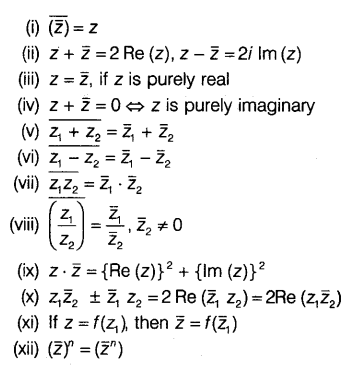
Modulus of a Complex Number
Let z = x + iy be a complex number. Then, the positive square root of the sum of square of real part and square of imaginary part is called modulus (absolute values) of z and it is denoted by |z| i.e. |z| =
It represents a distance of z from origin in the set of complex number c, the order relation is not defined
i.e. z1 > z2 or z1 < z2 has no meaning but |z1| > |z2| or |z1|<|z2| has got its meaning, since |z1| and |z2| are real numbers.
Properties of Modulus of a Complex number
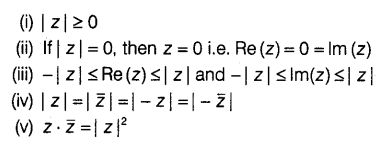
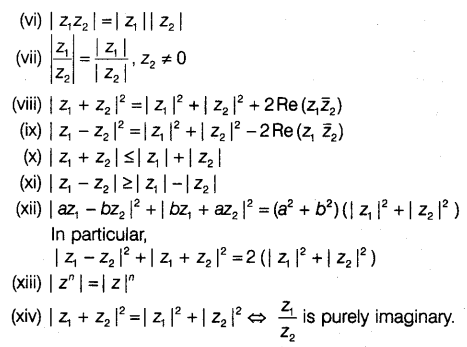
Argand Plane
Any complex number z = x + iy can be represented geometrically by a point (x, y) in a plane, called argand plane or gaussian plane. A purely number x, i.e. (x + 0i) is represented by the point (x, 0) on X-axis. Therefore, X-axis is called real axis. A purely imaginary number iy i.e. (0 + iy) is represented by the point (0, y) on the y-axis. Therefore, the y-axis is called the imaginary axis.
Argument of a complex Number
The angle made by line joining point z to the origin, with the positive direction of X-axis in an anti-clockwise sense is called argument or amplitude of complex number. It is denoted by the symbol arg(z) or amp(z).
arg(z) = θ = tan-1(
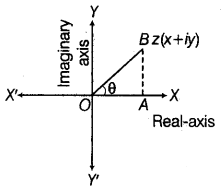
Argument of z is not unique, general value of the argument of z is 2nπ + θ, but arg(0) is not defined. The unique value of θ such that -π < θ ≤ π is called the principal value of the amplitude or principal argument.
Principal Value of Argument
- if x > 0 and y > 0, then arg(z) = θ
- if x < 0 and y > 0, then arg(z) = π – θ
- if x < 0 and y < 0, then arg(z) = -(π – θ)
- if x > 0 and y < 0, then arg(z) = -θ
Polar Form of a Complex Number
If z = x + iy is a complex number, then z can be written as z = |z| (cosθ + isinθ), where θ = arg(z). This is called polar form. If the general value of the argument is θ, then the polar form of z is z = |z| [cos (2nπ + θ) + isin(2nπ + θ)], where n is an integer.
Square Root of a Complex Number
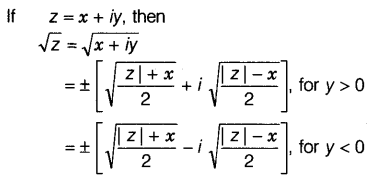
Solution of a Quadratic Equation
The equation ax2 + bx + c = 0, where a, b and c are numbers (real or complex, a ≠ 0) is called the general quadratic equation in variable x. The values of the variable satisfying the given equation are called roots of the equation.
The quadratic equation ax2 + bx + c = 0 with real coefficients has two roots given by
Note:
(i) When D = 0, roots ore real and equal. When D > 0 roots are real and unequal. Further If a,b, c ∈ Q and D is perfect square, then the roots of quadratic equation are real and unequal and if a, b, c ∈ Q and D is not perfect square, then the roots are irrational and occur in pair. When D < 0, roots of the equation are non real (or complex).
(ii) Let α, β be the roots of quadratic equation ax2 + bx + c = 0, then sum of roots α + β =









No comments:
Post a Comment